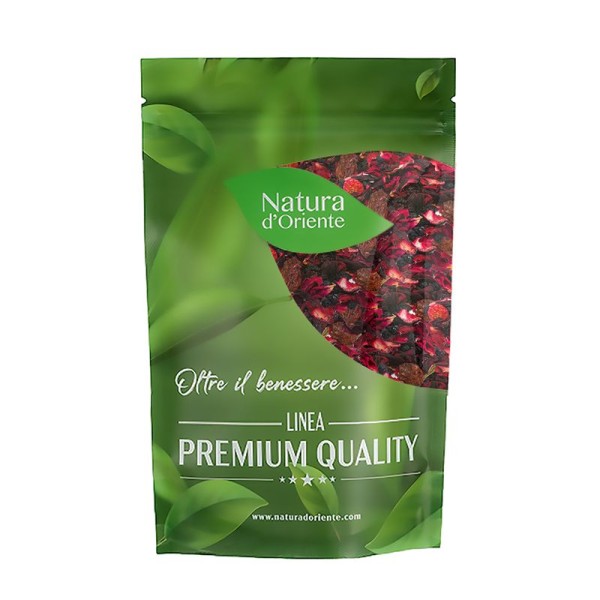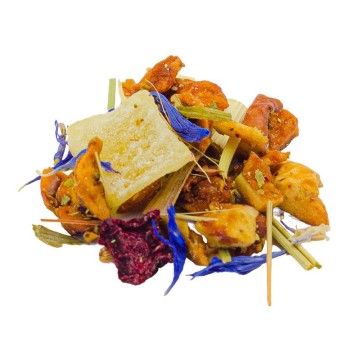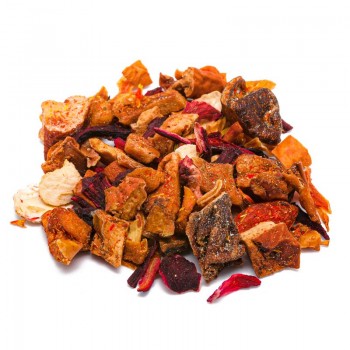wild berries , especially red fruits, are rich in precious elements for our well-being thanks to their antioxidants. In addition, their taste, even in the cold winter, can bring us back to the warmth and aromas of sun-kissed fruits. Rose petals , natural aroma, black currant, red ribers, blackberries ... exquisite fruity flavor but also the many properties!
Infusion of red fruits: properties and benefits
These berries and fruits contain a high dose of vitamins and antioxidants. They are excellent eaten fresh or dried, but if we want to appreciate their qualities during the cold season, we can prepare hot infusions. Or, they can be used as refreshing drinks in summer.
Thanks to this mix, the herbal tea with red fruits is an adjuvant for various conditions of our organism. We know that red fruits, mostly berries, are a very large group of fruits that are characterized by having, in addition to the red or dark red hue, an acid taste and precious nutrients. They provide many health benefits, such as antioxidants, vitamins, minerals and phytonutrients .
First of all, this infusion is known due to its beneficial properties for blood circulation. Some substances contained in these fruits, such as anthocyanins, are beneficial for our cardiovascular system. They are vegetable pigments that produce a red, purple or blue hue in fruits depending on their pH.
In addition to their coloring role, anthocyanins can play a role in heart health by neutralizing free radicals that are harmful to our cells. They mitigate inflammation and protect arteries by strengthening the walls of capillaries and blood vessels. They help the circulation, therefore, up to the microcirculation.
anthocyanin glycosides, or anthocyanins , can strengthen the connective tissue structure of blood vessels, improving their tone and elasticity; help to block capillary fragility.
Especially for those suffering from circulatory disorders, such as in the case of varicose veins, varicose veins or hemorrhoids, red fruits can be useful. They can also be suitable for relieving swelling in the legs and heaviness, reactivating circulation. The potential on microcirculation is an aspect that was also considered a male aphrodisiac in the past.
To counteract poor blood circulation and for the well-being of the cardiovascular system, we know that they are precious foods rich in anthocyanins (antioxidant flavonoids) and vitamin C, such as red fruits. To maintain heart health, red fruits also contain magnesium, which helps our vital organ function properly.
The anthocyanins contained in the infusion of red fruits are also useful for sight, since they promote the well-being of the retina.
This red fruit infusion is also an excellent infusion for those with digestive problems, as they help improve intestinal transit thanks to their high fiber content and some organic acids (citric , malic, tartaric, oxalic, etc.).
These fruits prevent constipation by promoting regular bowel movements, absorbing water in the lower digestive tract and helping in elimination of toxins.
The purification effect helps the colon with the correct intestinal transits, and also the urinary tract with its detox and diuretic action due to potassium. In addition, the red fruit infusion it is suitable for those who need to regain skin balance , thanks to the presence of cranberry rich in vitamin C and mineral salts .
Loved by women, the red fruit tea is able to slow down the aging process of the skin, thanks to the antioxidants that are also anti-aging. These fruits, which also include the anti-aging fruit par excellence, grapes, slow down premature decay and reduce the negative effects of free radicals.
In addition to the antioxidants that preserve the hyaluronic acid in the epidermis, to make it smoother and more luminous, precious mineral salts are also present in the infusion in terms of hydration.
This infusion, in fact, is also a refreshing and moisturizing herbal tea . In addition to being a powerful antioxidant, it maintains bone health thanks to the source of vitamin K, which retains calcium in the bone matrix.
These red fruits also strengthen the immune system thanks to vitamin C, well known for its immunostimulating properties.
The wild fruit tea also promotes relaxation. In reality, with these ingredients, nothing is missing to help our body stay fit and purified. A cure-all for mind and body.
Origins and History of cultivation
In this mix there are several berries or natural elements that help our health. To create this infusion, hibiscus, elderberries, grapes, rose petals, black currants, red currants, blackberries were dried.
The various plants are partly wild berries, partly peculiarities such as hibiscus flowers and rose flowers, known for their beneficial properties and vitamins. plants has been cultivated by humans since ancient times, such as grapes also mentioned in the bible.
In some cases, the spread of these foods increased with the Middle Ages, when more goods and plants for grafting began to circulate, and even different fruits entered our diet To date, even red fruits or other foods are easily available everywhere, and in all seasons, thanks to the infusion of dried petals and berries.
Plant and flowers
The components of the herbal tea are many, and the mix contains berries and fruits of various origins.
We propose a infusion with hibiscus petals, rose petals, elderberries, grapes, black currant, red currant, blackberry .
Red currant is Ribes rubrum , a perennial plant belonging to the Grossulariaceae family, native to Western Europe. This small shrub is very branched, loves the winter climate, which stimulates its fruiting.
The black currant (Ribes nigrum ), is a shrub of the Grossulariaceae family cultivated for its edible berries. It is native to the temperate areas of Europe and northern Asia, where it prefers moist and fertile soils.
The Hibiscus or Hibiscus is a plant of the mallow family. The genus includes hundreds of species, native to warm temperate, subtropical and tropical regions around the world. The large flowers are those used in herbal medicine.
The Rose is a perennial shrub of the rose family (Rosaceae), native to the temperate regions of the northern hemisphere. Notes for the beautiful flowers, with a delicious scent, they also give the buds for a beneficial infusion. The blackberry is the bramble fruit of the Rubus Fruticosus L. shrub of the large Rosaceae family. It grows spontaneously in the Mediterranean countries, as a climbing and thorny plant, which gives life to the traditional blackberry groves.
Elderberries derive from the European Sambucus nigra, belonging to the Adoxaceae family. It is a shrub found in Europe and Western Asia, and it grows in humid places such as swamps and marshes. The grape is the famous Vitis Vinifera which gives us its juicy bunches. Plant known for millennia, which is thought to be native to India, and which spread first in Asia and then in the Mediterranean basin.
Nutritional values of the infusion of red fruits
The infusion contains various vitamins, Group B and vitamin C , as well as moderate doses of vitamin K, and vitamin E. In addition, red fruits contain minerals such as iron, magnesium, manganese, phosphorus, potassium, and calcium. In terms of antioxidants, flavonoids, carotenoids and anthocyanins abound.
In addition, red fruits contain beneficial dietary fiber .
How to use red fruits in herbal tea
The infusion is obtained by putting the mixture of red fruits with water at 100 ° C into a cup (250 ml).
Leave to infuse for 10 to 12 minutes, before drinking the herbal tea.
Add honey or sugar if you wish.
Infusion of red fruits: side effects and contraindications
Both the berries and the flowers contained in the herbal tea are usually considered safe, maintaining the recommended doses. However, it is good to evaluate the ingredients in case of allergies or intolerances.
Most red fruits, infacts, it can release histamine in the body; therefore it is good to evaluate the individual foods contained in the infusion, if they can trigger an allergic reaction.
caution is also advised for pregnant and breastfeeding women - when histamine may leak into breast milk.
In addition, excessive doses can cause side effects such as mild diarrhea and intestinal gas formation.

![infuso frutti rossi [Natura d'Oriente] infuso frutti rossi [Natura d'Oriente]](https://www.naturadoriente.com/3542-large_default/infusion-of-red-fruits.jpg)




![infuso frutti rossi [Natura d'Oriente] infuso frutti rossi [Natura d'Oriente]](https://www.naturadoriente.com/3542-home_default/infusion-of-red-fruits.jpg)




 No reward points for this product.
No reward points for this product.













![infuso pesca e vaniglia [Natura d'Oriente]](https://www.naturadoriente.com/3538-home_default/infused-peach-vanilla.jpg)

